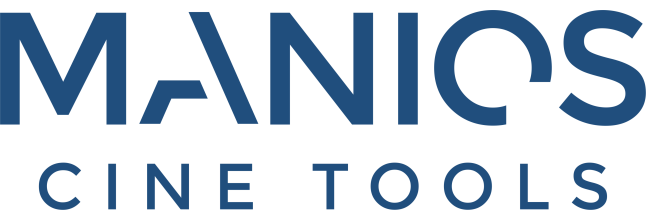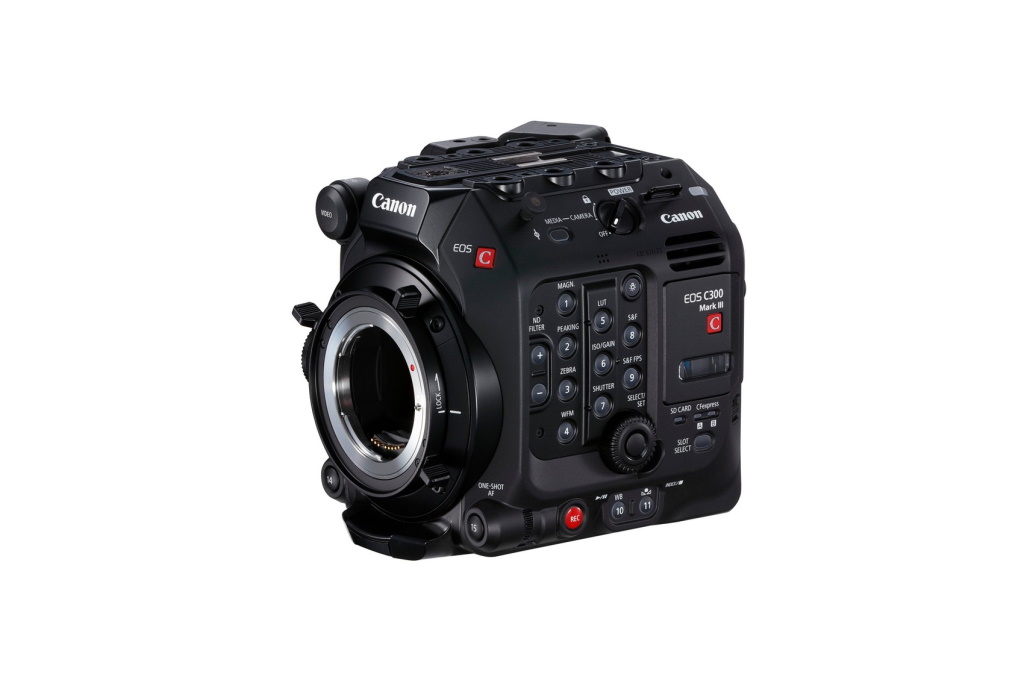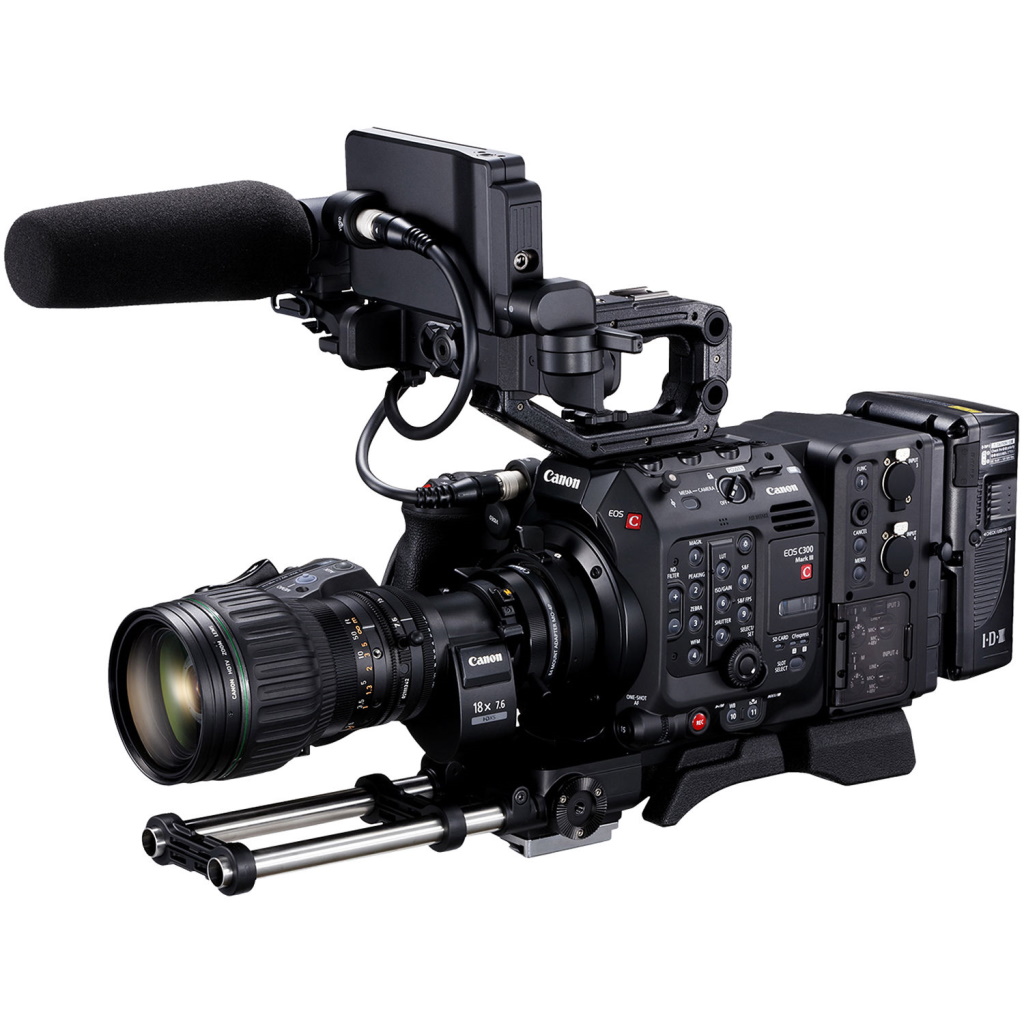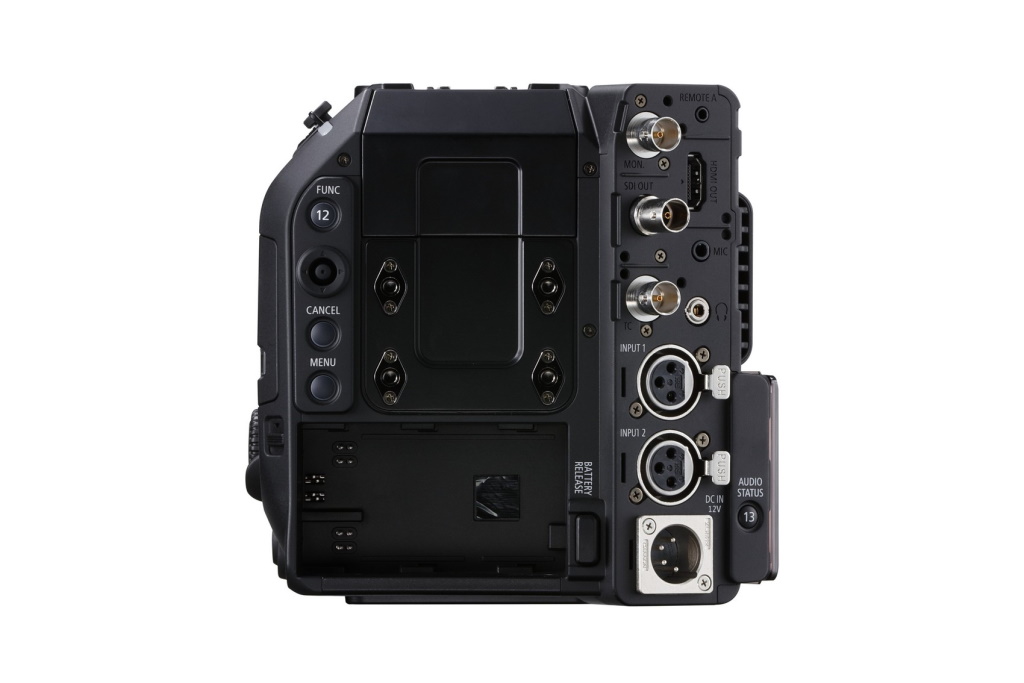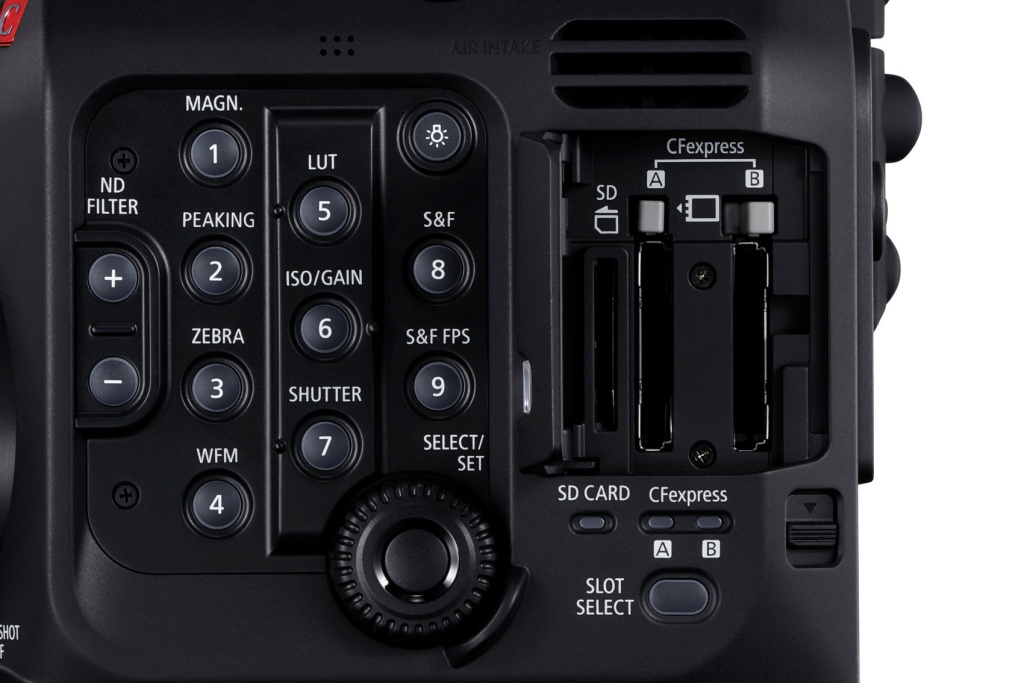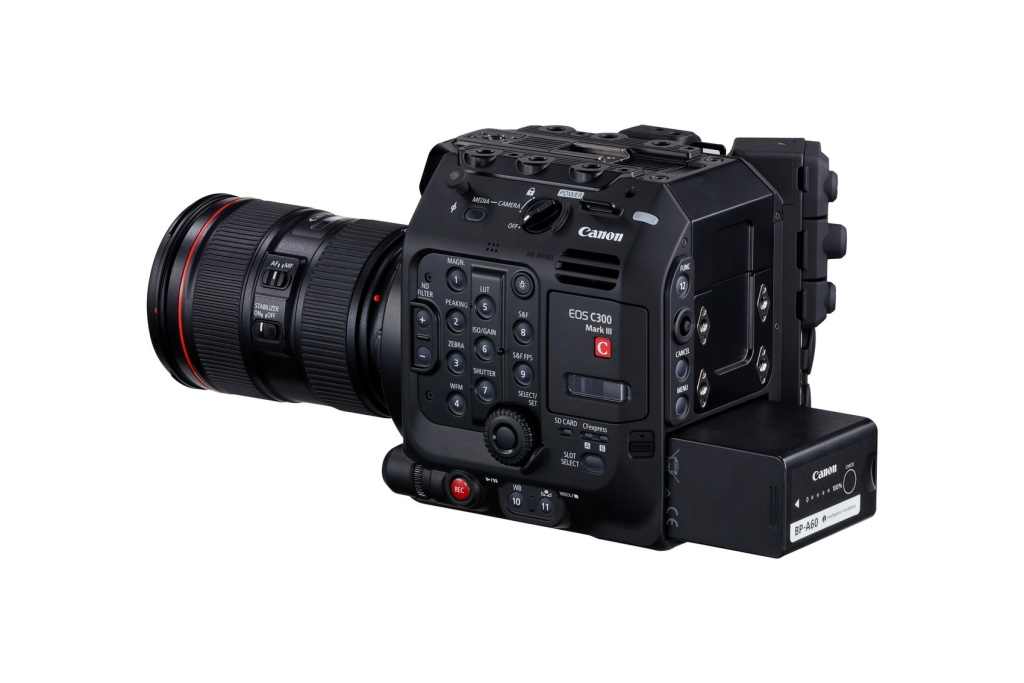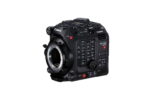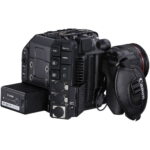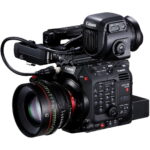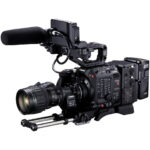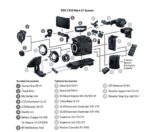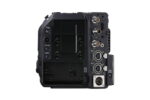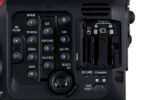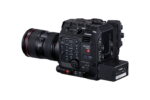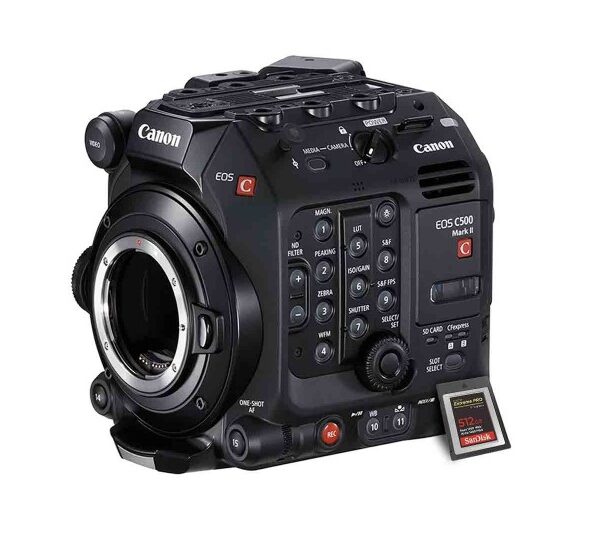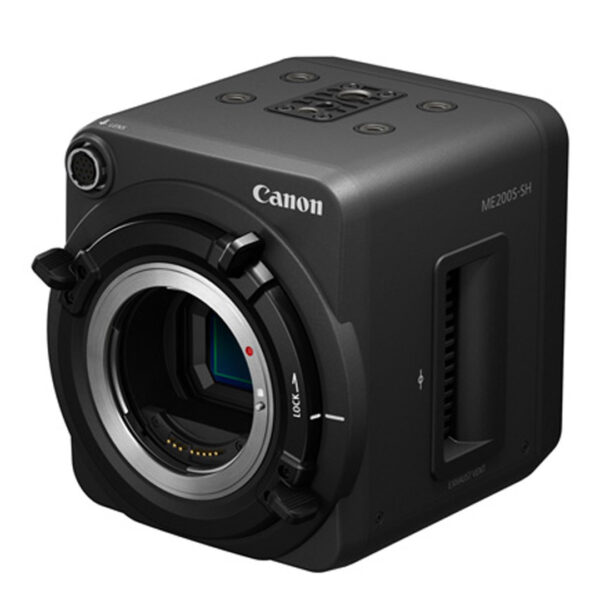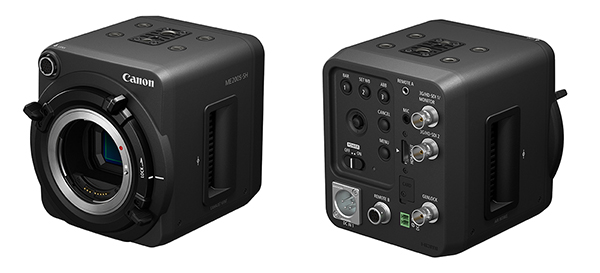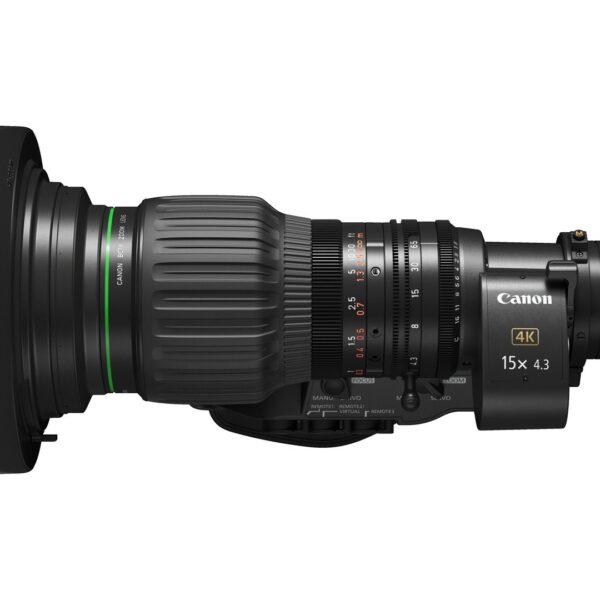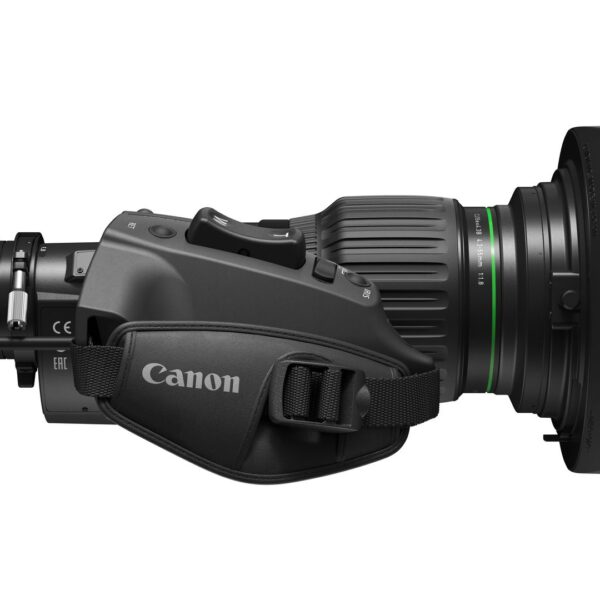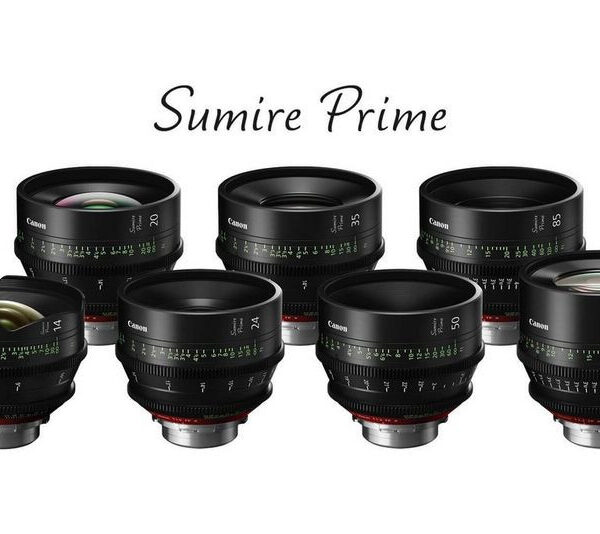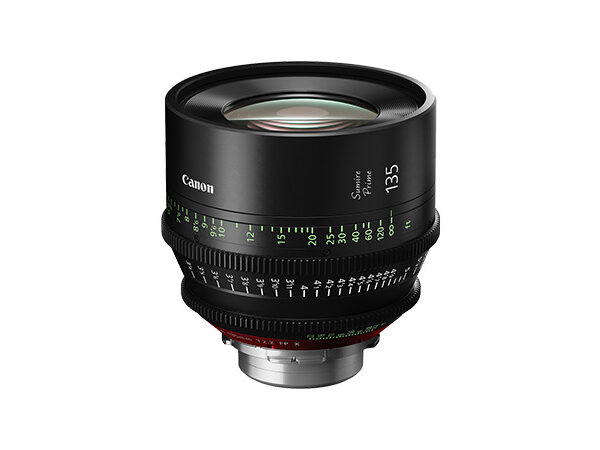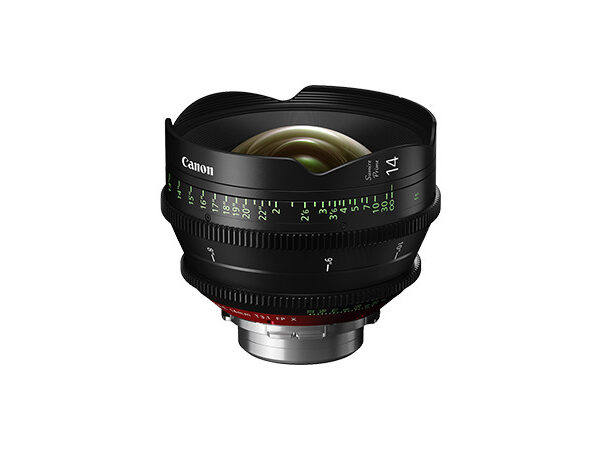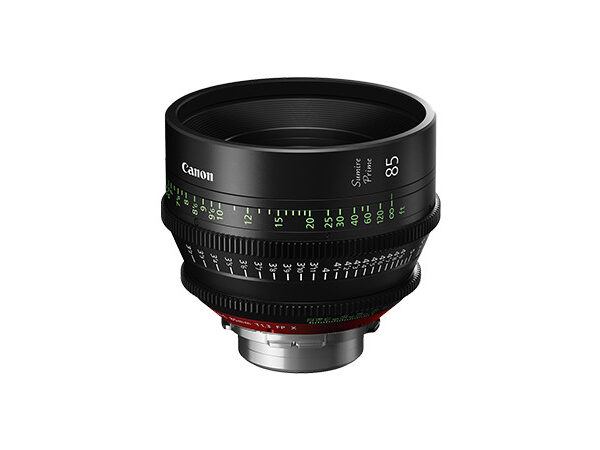EOS C300 Mark III Digital Cinema Camera
Features:
- NEW! Canon Super 35mm Dual Gain Output (DGO) Sensor:
The EOS C300 Mark III features Canon’s next generation Super 35mm Dual Gain Output (DGO) Sensor. This new sensor is capable of dynamic ranges in excess of 16 stops and is compatible with Canon’s exclusive Dual Pixel CMOS Autofocus technology.
The DGO Sensor is a newly developed imaging system that generates high dynamic range and maintains low noise levels by reading out each pixel with different gains. It combines images using pixels shot with a saturation-prioritizing amplifier for bright areas and a lower-noise noise-prioritizing amplifier for darker areas.
- DIGIC DV7 Image Processor, which powerfully processes high-resolution image data:
The EOS C300 Mark III features Canon’s DIGIC DV7 image processor that takes the extensive RAW information captured from the imaging sensor and processes it for output. DIGIC is also the engine behind features such as high frame rate recording, Dual Gain Output (DGO) Sensor, Dual Pixel Autofocus, Cinema Raw Light Recording, HDR (PQ) output, Electronic Image Stabilization and proxy recording.
- High Frame Rate; 4K 120p and 2K CROP 180p:
The EOS C300 Mark III is capable of ultra-high frame rates with its new chip design and DIGIC DV7 image processor. Frame rates up to 120 fps can be obtained in 4K, while 2K CROP mode provides even greater flexibility with speeds up to 180 fps.
- Modular Design with three available Expansion Units allows for a high level of connectivity and interoperability:
A new modular design allows productions to optimize and customize the EOS C300 Mark III to specific shooting needs. Accessories and expansion units can be easily attached to provide different levels of functionality. The camera is equally at home fully rigged with a large zoom lens, FIZ unit, audio accessories and rangefinder as it is stripped down flying on a drone.
- Canon Log 2 and 3:
The EOS C300 Mark III supports both Canon Log 2 and Canon Log 3 Gamma. In post-production, Canon Log is designed to reproduce the entire tonal range that the CMOS image sensor is capable of. Log workflows provide the user with higher dynamic range, more highlight and shadow retention as well as more flexibility in grading.
Canon Log 2 provides the largest dynamic range and image detail. While Canon Log 2 provides the most post-production flexibility and full dynamic range of the sensor, it typically requires more time in color correction.
For users looking for most of the benefits of log workflow but with shorter turnaround times, Canon Log 3 provides an alternative with only a slightly reduced dynamic range of 14 stops.
- LM-V2 4.3″ LCD Touch Screen Monitor:
The LM-V2 4.3″ LCD Monitor is an easy-to-view touch panel with approximately 2.76 million dots. The monitor easily attaches to the EOS C300 Mark III using included accessories and can be adjusted to different viewing positions. The LCD monitor is capable of displaying both image framing and visual confirmation of camera settings. Additionally, the display has a control interface to make it easy to access and change camera settings.
- 4-Channel Audio Recording:
The EOS C300 Mark III supports up to 4-channel audio recording. Audio input from the camera’s internal microphone, mini mic port, and XLR ports can be assigned to the 4 different audio channels. With Expansion Unit EU-V2, a total of 4 XLR ports are supported. This flexibility allows a wide range of audio devices to be connected and mixed directly on the camera.
- Support for Custom User LUTs:
Users can upload and apply custom LUTs to the EOS C300 Mark III. LUTs can be assigned to specific output terminals, the LCD and the viewfinder. Clients can be viewing one LUT while production works from another, giving different production roles the ability to customize the look of the image to their needs.
- User Interchangeable Lens Mounts, which give users freedom to use the lenses they desire:
User interchangeable lens mounts and an available B4 mount adapter gives operators the freedom to make bold creative choices based on the subject matter.
The EOS C300 Mark III ships with an EF mount that can be user-swapped to an optional Locking EF (EF-C) or PL mount. Each mount swaps easily with a simple removal of four M3 hex screws. A shim set is provided with each mount kit in order to adjust back focus for the precision in focusing accuracy that professionals rely on.*
* Depending on the mount the user has in place. Mounts need to be both swapped and shimmed correctly.
- Anamorphic Lens Support:
The EOS C300 Mark III offers cinematographers support for the use of both 2.0 and 1.33 anamorphic lens types. Users can achieve the wide cinematic looks, oval bokeh, and striking flares particular to anamorphic glass. It is a distinctly cinematic palette that is within reach for your next project.
- Canon Cinema RAW Light and XF-AVC Recording:
Thanks to the powerful DIGIC DV7 image processing platform, the EOS C300 Mark III can record Cinema RAW Light directly to onboard CFexpress™ cards. Cinema RAW Light offers plenty of freedom for grading with a dynamic range that can exceed 16 stops with Dual Gain Output (DGO) technology, while maintaining file sizes that are about 1/5 to 1/3 the size of Canon Cinema RAW. Canon Cinema RAW Light offers a great combination of codec efficiency and quality.
In addition to the conventional Intra-based XF-AVC codecs, we have added a 4:2:2 10 bit Long GOP-based codec with consideration for a balance of quality and data rates. This new Long GOP-based codec has a data rate that is less than half that of the conventional Intra codecs. This new lightweight codec makes it easier for users to reduce media costs and work with cloud-based infrastructures.
The EOS C300 Mark III Digital Cinema Camera incorporates the new Canon XF-AVC codec that allows 4K and 2K image data to be recorded internally onto CFexpress™ cards in workflow-efficient file sizes using advanced video compression. Using the XF-AVC codec, the EOS C300 Mark III can record a variety of frame fates up to 4K 120p and 2K up to 180p.
- Proxy Recording:
Higher resolution, greater bit depths and faster frame rates provide versatility and greater image quality, but come at the cost of much larger file sizes. Proxy files can greatly speed up the editorial process by providing a lower bandwidth alternative for initial file sharing and rough cutting.
Canon’s powerful, high-speed DIGIC DV7 image processor makes it possible for the EOS C300 Mark III to simultaneously record 2K Proxy files. Cinema RAW Light can be recorded to the internal CFexpress™ card while an XF-AVC 2K 4:2:0 8-bit Proxy can be recorded directly to an internal SD card. The EOS C300 Mark III can apply LUTs to Proxy recording.
- Electronic Image Stabilization:
The EOS C300 Mark III includes the same built-in five-axis electronic IS introduced with the EOS C500 Mark II that works with almost any lens, including anamorphic.
- 12G SDI:
Support for 12G SDI allows the EOS C300 Mark III to output 4K resolution up to 60p over a single BNC cable.
- Dual Pixel CMOS Autofocus with support for Touch AF and Face Detection:
The Cinema EOS C300 Mark III features Canon’s Dual Pixel CMOS AF technology. For DAF, each pixel in the camera’s CMOS sensor is configured with two photodiodes. Two independent image signals can then be detected at each photosite and compared using phase-difference to provide autofocus with compatible lenses. DAF can survey the scene and recognizes not only whether the subject is in focus or not, but also in which direction (near or far) and by how much. DAF also powers the intuitive Focus Guide for users who prefer to focus manually but enjoy the positive feedback DAF provides through the guide interface.
- RC-V100 Support and LANC Compatible:
The EOS C300 Mark III body has a remote A terminal (LANC) on the body and supports remote B (RS422) in both expansion unit EU-V1 and EU-V2. Through these connectors, the EOS C300 Mark III can be completely remote operated either by a standard LANC compatible cable or over longer distances through the use of a serial connection.
Specifications:
- Imaging Sensor
Effective Pixels:
4096×2160: when 4096 x 2160 or 2048 x 1080 is selected as the resolution (Approx. 8.85 megapixels)
3840 x 2160: when 3840 x 2160 or 1920 x 1080 is selected as the resolution (Approx. 8.29 megapixels)
Total Pixels: 4206 x 2280. Approx. 9.6 megapixels
Sensor Type: CMOS
Sensor Size:
Super 35mm
4K: 26.2 x 13.8 (29.6 mm diagonal)
UHD: 4K: 24.6 x 13.8 (28.2 mm diagonal)
Sensor Modes: Super 35mm, Super 16mm(cropped)
Pixel Pitch: 6.4 µm
Scanning System: Progressive
Number of Sensors: 1
Filter: RGB Primary Color Filter (Bayer Array)
Imaging Processor: DIGIC DV7
- Lens System:
Lens Mount:
Default Mount: EF
Optional: EF-C locking, PL
*All mounts are interchangeable
**Supports both EF and EF-S lens
Zoom/Focus Preset: Not Available
Shockless Zoom: Not Available
Digital Teleconverter: Not Available
ND Filter: Mechanical ND filter system with option of clear, 2, 4, and 6 stops; 8 and 10 stops in extended mode
Peripheral Illumination Correction: Available
- Exposure and Metering:
Exposure Modes:
(1) Manual exposure based on shutter setting, iris setting, ISO/gain setting, and ND filter setting
(2) Push auto iris control, auto iris control
Metering Modes: Standard, Spotlight and Backlight
Gain:
Normal Setting -6dB to 54dB TBD
Fine Setting -2dB to 54dB in 0.5 dB increments
ISO: 100 to 102,400
Auto Gain Control (AGC): Not Available
Shockless Gain: Not Available
Exposure Compensation/AE Shift: –2.0 to +2.0 in 0.25 point intervals
Shutter Modes:
3 Modes: OFF; Speed; Angle; Slow Shutter; Clear Scan
Speed Mode is selected in 1/3 or 1/4 stop increments
Shutter Speed Range:
59.94Hz/24.00Hz: 1/12 to 1/2000
50.00Hz: 1/12 to 1/2000
Shutter Angle Settings:
59.94Hz/50.00Hz/24.00Hz: 360, 240, 180, 120, 90, 60, 45, 30, 22.5, 15, 11.25
Iris Settings (EF):
Can be set to 1/2 stop, 1/3 stop or Fine.
(1) Push auto iris control
(2) Auto iris control (Compatible lens required)
(1/2, 1/3 stop or fine setting can be selected)
- Focus:
Focus Control: Dual Pixel CMOS AF
Focus Modes:
Manual focus, continuous AF, one-shot AF, AF-Boosted MF, face detection AF
Only lenses that support AF functions can be used in AF modes
- External Recording Output:
System Frequency:
59.94 Hz, 50.00 Hz, 24.00 Hz
59.94 Hz mode: 59.94i/59.94P/29.97P/23.98P
50.00 Hz mode: 50.00i/50.00P/25.00P
24.00 Hz mode: 24.00P
Resolution:
| Mode | Resolution | Frame Rates |
| Cinema RAW Light | 4096×2160 | 59.94p / 29.97p / 23.98p / 50.00p / 25.00p / 24.00p |
| 2048×1080 | 59.94p / 29.97p / 23.98p / 50.00p / 25.00p / 24.00p |
|
| XF-AVC | 4096×2160 / 3840×2160 | 59.94p / 29.97p / 23.98p / 50.00p / 25.00p / 24.00p |
| 2048×1080 / 1920×1080 | 59.94p / 29.97p / 23.98p / 50.00p / 25.00p / 24.00p/ 59.94i / 50i |
|
| 1280×720 | 59.94p / 50p |
Color Gamuts: Cinema Gamut, BT.709, BT.2020
Gamma Curves: BT.709, Wide DR, Canon Log 2, Canon Log 3, PQ, HLG
- Recording / Codec:
Codecs:
XF-AVC (10 bit 4:2:2 (CFexpress) or 8 bit 4:2:0 (SD card))
Cinema RAW Light (CFexpress)
Recording Media:
CFexpress 2,0 (Type B) x 2 slots
SD Card (Still Images (JPEG), Custom Picture Data, Clip Metadata, and menu settings); SD/SDHC/SDXC Supported
Recording Time:
| Cinema RAW Light | ||||
| CFexpressTM | 1 Gbps | 250 Mbps | ||
| 512 GB | 64 Minutes | 256 Minutes | ||
| Intraframe | ||||
| CFexpressTM | 810 Mbps | 410 Mbps | 310 Mbps | 160 Mbps |
| 512 GB | 79 Minutes | 156 Minutes | 207 Minutes | 401 Minutes |
| Long GOP | ||||
| CFexpressTM | 260 Mbps | 160 Mbps | 50 Mbps | 24 Mbps |
| 512 GB | 246 Minutes | 401 Minutes | 1284 Minutes | 2675 Minutes |
| Long GOP | ||||
| SD | 35 Mbps | 24 Mbps | 17 Mbps | |
| 512 GB | 1945 Minutes | 2840 Minutes | 4010 Minutes | |
File Format:
XF-AVC: MXF (OP-1a)
RAW: CRM
File System:
CFexpress: exFat
SDHC card: (up to 32 GB): FAT32
SDXC card (more than 32 GB): exFAT
File division unit: 4 GB for FAT32, none for exFAT
Maximum Clip Number: 999 (per media)
- Audio:
Recording Format: Linear PCM; 4-Channel; 24-Bit; 48 kHz
Built-in Microphone: Monaural
External Audio Inputs:
2–XLR inputs (Auto and Manual level settings)
External microphone terminal: (3.5 mm diameter)
Recording Chanel Selection: Up to 4 channel audio recording is supported
XLR Mic Trimming: Available; -12dB, -6 dB, 0dB or +12 dB
Limiter: Available
Recording Level Adjustment Range: -Infinity to +18dB
Phantom Power: Available; +48V
Headphone Adjustment: 16 Settings; Volume is muted at lowest setting
Built-in Speaker: Available; Volume Adjustable
1KHz Tone: Available (off, -12, -18, or -20 dB)
- Features and Performance:
Playback:
Clip Display: 3×4 Index Display.
Clip Playback: Forward Search (x5, x15, x60), Reverse Search (x5, x15, x60), Forward frame Advance, Reverse Frame Advance, Record Review, Skip to next clip, skip to previous clip
Clip information Display: Clip Metadata display, custom picture settings
Playback Functions: Clip Delete
Photo Playback: index, single playback, delete, protect
Slow and Fast Motion Recording:
Available; Records at a different frame rate then the playback rate allowing for fast and slow motion effects:
| Sensor Mode | Recording Mode | Available Frame Rates | ||||
| Super35 | Cinema RAW Light |
|
||||
| Super16(Crop) | Cinema RAW Light |
|
||||
| Super35 | XF-AVC |
|
||||
| Super16(Crop) | XF-AVC |
|
Special Recording Functions: Relay Recording*; Double-Slot Recording**
* Not available during Slow Motion recording
** Not available in combination with Slow and fast motion recording or relay recording
Photo Recording Mode: Available; Images captured to SD Card
Waveform Monitor:
Available (HDR Compatible);
(a) Line display
(b) Line + spot: Line display over a red waveform in a red frame.
(c) Line select display
(d) RGB (parade)
(e) YPrPb (parade)
Output gain can be selected as either 1x or 2x. With gain set to 2x, the vertical axis (Y-position) offset value can be chosen.
When gamma is set to PQ, an PQ index (nits index) can be displayed. When gamma is set to HLG, an HLG index (0.0–1.0 relative index) can be displayed.
Vectorscope: Available
False Color: Available
Exposure / Focus Aids: Peaking (2 types), Zebra Pattern, Magnify, Black and White Mode, Focus Guide
Frame Record: Not Available
Pre-Record: Yes, 3 seconds cache (Audio and Video)
Time code: Drop Frame (DF) and Non-Drop Frame (NDF)
Time Code Modes: Regeneration, Record Run, Free Run and External Source
Auto White Balance (AWB): Available
White Balance:
Kelvin Setting:
2,000K to 15,000K in 100K increment
-20CC to +20CC in 1 CC increments
White Balance Presets: Daylight (5,600K); Tungsten (3,200K), Custom A, Custom B
Auto Black Balance: Available
Custom Picture Settings:
20 Custom Picture settings
Custom pictures can be adjusted using the following settings and saved for later recall:
Gamma, Black, Black Gamma, Low Key Saturation, Knee, Sharpness, Noise Reduction, Skin Detail, Selective Noise Reduction, Color Matrix, White Balance, Color Correction, Setup Level
Custom Pictures can be saved to an SD card for later use or transferring between cameras
Custom Display: Yes; LCD panel and EVF information display can be customized
On Screen Markers:
Available marker options include center, horizontal, grid, aspect, safety zone, and user marker.
With user markers, user can set their preferred size and position.
Markers can be displayed in yellow, blue, green, red, black, gray, or white.
Assign Buttons:
18 total assignable button (15 assign buttons provided on camera body, 1 on the grip and 2 buttons on the monitor unit)
Color Bars:
Color bars compliant with SMPTE, EBU, or ARIB standards can be selected depending on system frequency selected
Sensitivity:
59.94 Hz: f/10 (2048×1080/59.94P) or f/14 (1920×1080/29.97P)
50.00 Hz: f/11 (2048×1080/50.00P) or f/16 (1920×1080/25.00P)
All values for ISO 800, 2000 lux, and reflectance rate of 89.9%
Dynamic Range:
Canon Log 2: 1600% / 16+ stops (ISO 800)
Canon Log 3: 1600% / 14 stops (ISO 800)
- LCD Monitor:
Type:
4.3-inch (10.9 cm diagonal) color wide-screen LCD
Approx. 2,760,000 dots (1280 x RGB x 720)
Aspect Ratio: 16:9
Field of View Coverage: 100%
Display Adjustments: Brightness, Contrast, Color, Sharpness, and Luminance
- Input/Output:
SDI Out:
HD: SMPTE 292
3G: SMPTE 424, SMPTE 425
6G: SMPTE ST 2081
12G: SMPTE ST 2082
Audio: SMPTE ST 299
BNC Connector, output only
Monitor Out: Available
Resolution: 2048×1080 / 1920×1080
Frame Rates: 23.98p/24.00p/25.00p/29.97p/30p/59.94p/50p/60p
Time code In/Out: Yes; BNC Connector (Input and Output)
Genlock:
Supported when optional expansion unit EU-V1 or EU-V2 in attached (Shares function with Synch Out)
Adjustment range: -1023 to +1023
Synch Out:
Supported when optional expansion unit EU-V1 or EU-V2 in attached (Shares function with Genlock)
HD tri-level signal (HD Sync) 1920×1080: 59.94i/50i/23.98/24.00, 1280×720: 59.94p/50p/23.98, 24.00
HDMI:
Yes (Type A)
[4096×2160/3840×2160]/1920×1080/1280×720
Audio Input Terminal:
2–Balanced 3-pin XLR (Mic Level, Mic Level with phantom power and Line Level)
3.5mm Microphone terminal
Headphone Jack: Available; 3.5mm stereo mini-jack
Remote Terminals:
Remote A (Standard – LANC Compatible or RC-V100)
Remote B available In conjunction with expansion unit EU-V1 and EU-V2
Remote control through WFT-E9
USB: Available
CCU: Optional RC-V100
- Power:
Supply: 14.4V DC (Battery Pack)
Power Terminal:
DC IN 12V jack: DC 11.5V – 20V
DC 12–20V (using V-mount battery with EU-V2)
Battery: BP-A Series
Compact Power Adapter: CA-CP200B
- Accessories:
Tripod Adapter: Canon TA-100
Wi-Fi Adapter: WFT-E9
Expansion Units: EU-V1, EU-V2
EVF: EVF-V50, EVF-V70
Mounts: PL Mount Kit PM-V1, EF Cinema Lock Mount Kit CM-V1
Adapter: MO-4E (EF to B4), MO-4P (PL to B4)
- Other:
Dimensions:
(Width x height x depth, excluding cable and grip belt)
Body Only: Approx. 153 x 148 x 168 mm (6.0 x 5.8 x 6.6 in.)
Body and Grip: Approx. 183 x 148 x 189 mm (7.2 x 5.8 x 7.4 in.)
Body, Grip, Handle, Mic Holder, LCD Monitor LM-V2 and Expansion Unit EU-V2: Approx. 343 x 277 x 333 mm (13.5 x 10.9 x 13.1 in)
Weight:
EF Camera body (without Camera Grip GR-V1 or thumb rest) Approx. 1.75 kg ( 3.9 lb)*
*Body with PL Mount body; Approx. 2030g (4.5 lb.)
*Body with EF Cinema lock Mount body; Approx. 1860g (4.1 lb.)
Camera Grip GR-V1: Approx. 260 g (9.2 oz.)
LCD Monitor LM-V2: Approx. 204 g (7.2 oz.)
Handle unit: Approx. 227 g (8.0 oz.)
Battery Pack BP-A60: Approx. 434 g (15.3 oz.)
Compact Power Adapter CA-CP200B: Approx. 290 g (10.2 oz.) *Not including AC cable
Battery Charger CG-A20: Approx. 145 g (5.10 oz.)
Eyecap: Approx. 26 g ( 0.92 oz.)
Mic holder unit:Approx. 56 g ( 2.0 oz.)
LCD Attachment Unit LA-V2: Approx. 265 g (9.3 oz.)
Thumb rest: Approx. 9 g ( 0.32 oz.)
Extension System Attachment Bracket: Approx. 11 g (0.39 oz.)
Unit Cable UN-5: Approx. 80 g (2.8 oz.)
Body cap: Approx. 17 g (0.60 oz.)
Temperature and Humidity:
Performance requirements: 0ºC to 40ºC, 85% (relative humidity)
Operating requirements: -5ºC to 45ºC, 60% (relative humidity)
Language Support: English, Japanese, Chinese, German, Spanish, French, Italian, Korean, Russian
Time and Date: Automatic Calendar range January 1st, 2020 through December 31, 2050
World Clock: World Clock support – UTC time setting: Setting range from +14:00 to -12:00
In the box:
- Canon EOS C300 Mark III Camera Body (EF Mount)
- Canon GR-V1 Camera Grip
- Canon LM-V2 4.3″ LCD Monitor
- Canon LA-V2 LCD Attachment Unit
- Handle Unit
- SS-1200 Shoulder Strap
- Battery Charger CG-A20
- Compact Power Adapter CA-CP200 B
- AC Power Cable
- Power Cord
- Canon BP-A60 Battery Pack For EOS C300 Mark II, C200, and C200B
- Extension Unit Attachment Bracket
- Canon UN-5 Unit Cable
- 1/4″ Hex Wrench
- M3 Hex Wrench
- M4 Hex Wrench
- 1/4″ Hex Socket Head Bolt
- M3 Hex Socket Head Bolt
- Bolt Stopper
- Thumbrest
- Microphone Holder Unit
- M4 Screw for Microphone Holder Unit
